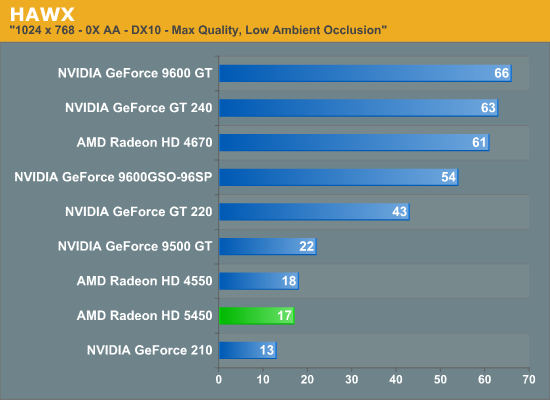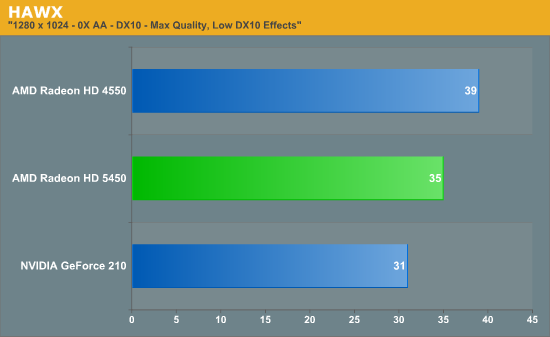AMD’s Radeon HD 5450: The Next Step In HTPC Video Cards
by Ryan Smith on February 4, 2010 12:00 AM EST- Posted in
- GPUs
HAWX


With everything but anti-aliasing and ambient occlusion enabled on HAWX, it’s playable at 1024 on everything at the GT 220 or higher level of performance. To get the 5450 to be playable, we needed to turn down the DX10 Sun and Shadow effects , which gave us enough power to be playable at 1280 without hurting the image quality too much more. Here the Radeon 4550 continues to win, while the GeForce 210 comes in a bit closer to the 5450 than it has in previous games.










77 Comments
View All Comments
Lifted - Thursday, February 4, 2010 - link
The first graph on each of the benchmark pages lists a 5670, the second graph lists a 4670. Typo or are you actually using different cards?Ryan Smith - Thursday, February 4, 2010 - link
It's not a typo. We never ran the 5670 at 1024x768, there was no reason to. It's more than fast enough for at least 1280.The 4670 data is from the GT 240 review, which we used 1024 on (because GT 240 couldn't cut the mustard above 1024 at times).
8steve8 - Thursday, February 4, 2010 - link
should have had the clarkdale igp in there for good measure, if you aren't gaming I'd guess that igp would be the way to goMrSpadge - Thursday, February 4, 2010 - link
Would have been interesting to compare idle power consumption: Clarkie + IGP vs. Clarkie + 5450.Ryan Smith - Thursday, February 4, 2010 - link
Testing a Clarkie requires switching out our test rig, so the results wouldn't be directly comparable since it means switching out everything including the processor. Plus Anand we only have a couple of Clarkies, which are currently in use for other projects.At this point Clarkie (and any other IGP) is still less than half as fast as 5450.
strikeback03 - Thursday, February 4, 2010 - link
That brings up the point though that with a card this low on the totem pole it might be nice to include a benchmark or two of it paired with similarly low-priced hardware. I understand the reason for generally using the same testbed, but when it is already borderline playable it would be nice to know that it won't get any slower when actually paired with a cheap processor and motherboard.Ryan Smith - Thursday, February 4, 2010 - link
Testing a Clarkie requires switching out our test rig, so the results wouldn't be directly comparable since it means switching out everything including the processor.At this point Clarkie (and any other IGP) is still less than half as fast as 5450.
kevinqian - Thursday, February 4, 2010 - link
Hey Ryan, I'm glad you are the first reviewer to utilize Blaubart's very helpful deinterlacing benchmark. I would just like to note that with ATI, it seems memory bandwidth plays a big part in deinterlacing method as well. For example, the HD 4650 DDR2 can only perform MA deinterlacing, even tho it has the same shaders as the (VA capable) 4670. The only bottleneck there seems to be the DDR2 memory bandwidth. On the other hand, with the HD 4550, though it has DDR3, it is limited to 64bit memory interface, so that seems to be a limiting factor.I have an old HD 2600Pro DDR2 AGP. When I OC the memory from 800mhz stock to 1000mhz, VA gets activated by CCC and confirmed in Cheese slices.
Nvidia's deinterlacing algorithm seem to be less memory intensive as even the GT220 with DDR2 is able to perform VA-like deinterlacing.
Ryan Smith - Thursday, February 4, 2010 - link
Yeah, I've seen the bandwidth idea thrown around. Unfortunately I don't have any additional suitable low-end cards for testing it.ET - Thursday, February 4, 2010 - link
I think I remember reading that the interpolation of input values in the pixel shader was moved from fixed function units to being done by the shaders.